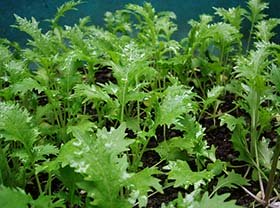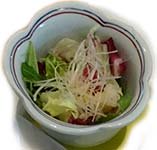Mizuna (Japanese) greens Nutrition facts
Mizuna greens (which translates to water greens in Japanese, 水菜) are mustard family plants native to the Kansai region of Japan.
Their frilly, edged, glossy, deep green leaves have been the favorite of chefs in the mesclun or Spring Mix salads.
Botanical name: Brassica juncea var. japonica.
 |
| Mizuna greens. Note for the bright-green, deep lobed leaves with serrated margins. (Photo: isaac'llclous) |
This cool-season annual plant is also popular as Japanese mustard (kyona) grows in clusters of long, pencil-thin, white stalks spreading into dark-green, crispy, deeply serrated leaves as in chervil.
Nearly two dozen different hybrid cultivars of mizuna greens developed as seasonal crops in Japan. It is a fast-growing herb that prefers well-drained, sandy, and moist soil to flourish. Seedling is done by late summer or early fall.
The crop usually takes about 40-50 days to grow and is suitable for harvesting at any stage from micro to mature greens. Fresh shoots grow again out of the harvested stumps. If left alone till the late spring when temperatures rise, the plant bolts giving rise to small clusters of yellow blossoms.
10 Amazing Health Benefits of Mizuna Greens
Being a cruciferous (Brassica) vegetable, mizuna incorporates all the antioxidant qualities of fellow mustard family members like mustard greens, napa cabbage, bok choy, etc.
Its leaves carry very low calories, about 23 calories/100 grams or 39 calories per 170 grams/stock (bundle). Nonetheless, its dark green leaves hold ample amounts of phytonutrients, vitamins, and minerals. Additionally, its stalks contain a very good amount of dietary fiber that helps control cholesterol levels by interfering with its absorption in the gut.
Adequate fiber in the food aids in smooth bowel movements, and thereby offers protection from hemorrhoids, constipation as well as colon cancer diseases.
It is an excellent sources of vitamin-K. 170 g of fresh leaves carry about 204 μg of vitamin K-1 (phylloquinone). Vitamin K plays a potential role in the bone mass-building function by promoting osteoblastic activity in the bone.
Vitamin-K also has an established role in limiting the neuronal damage in the brain in Alzheimer's disease patients.
Being a member of Brassica vegetables, it is a rich source of antioxidant glucosinolates. Other compounds found in it are flavonoids, indoles, sulforaphane, carotenes, lutein, and zeaxanthin. Indoles, mainly Di-indolyl-methane (DIM) and sulforaphane have proven benefits against prostate, breast, colon and ovarian cancers by virtue of their cancer-cell growth inhibition, cytotoxic effects on cancer cells.
Fresh leaves are also a modest source of the B-complex group of vitamins such as folic acid, pyridoxine, thiamin, riboflavin, etc. Folates are water-soluble vitamins that have a significant role in DNA synthesis, and cell division. When given to women during their peri-conception time, folic acid can help prevent neural tube defects in newborn babies.
Fresh mizuna leaves are an excellent sources of vitamin-C. 170 grams of fresh leaves provide 93.5 μg. Vitamin C (ascorbic acid) is a powerful natural antioxidant that offers protection against free radical injury and flu-like viral infections.
Mizuna leaves are also incredible sources of vitamin-A (provide 189 μg). Vitamin A is an essential nutrient required for maintaining healthy mucosa and skin. Consumption of natural fruits rich in flavonoids helps protect from lung and oral cavity cancers.
Fresh greens are an excellent source of several essential minerals such as molybdenum, calcium, iron, magnesium, manganese, potassium, zinc, and selenium.
Selection and storage
Fresh mizuna greens can be easily found in supermarkets year-round. In Japan, greens and blossoms can be a common scene in farmer markets during the spring season.
You can figure out light-color stalks with deeply lobed, frilly, and jagged-edge brilliant green leaves from a close look. Buy fresh greens packed in bunches or wrapped in a plastic cover, kept near other common greens like bok choy, spinach, kale, turnip greens, etc.
Avoid wilted, yellow, discolored leaves.
Preparation and serving methods
 |
| spring mix salad with mizuna, lettuce, and jicama |
Fresh mizuna leaves, flower buds, and stems can be used in a variety of cuisines all over Japan, South Korea, Taiwan, and China. Mizuna greens usage is rapidly increasing in the USA and Europe, thanks to the advent of better transportation and storage technologies.
Wash its leaves thoroughly in clean running water to remove any sand and soil. Trim away thick mid-ribs and stems.
Here are some serving tips:
Many traditional Japanese cooking styles use fresh mizuna greens. The greens go well with yosenabe, sukiyaki, ohitashi, hariharinabe, etc, served in the nabemono (Japanese hot pot) style.
Fresh, tender mizuna greens are a common item featuring in the mesclun or spring-mix along with lettuce, endive, chervil, and arugula.
This green is also used in soups. Braised/stir-fried, it mixes well with ham, pork, and bacon.
Safety profile
High phytate and dietary fiber content in the mizuna greens may interfere with the bioavailability of minerals like iron, calcium, and magnesium.
Because of its high vitamin-K content, patients taking anti-coagulants such as warfarin are encouraged to avoid this food since it increases the vitamin-K concentration in the blood, which is what the drugs are often attempting to lower. This may advertently raise the effective dose of the drug.
Being a mustard family plant, mizuna contains oxalic acid, a naturally occurring substance found in some vegetables, which may crystallize as oxalate stones in the urinary tract in some people. It is, therefore, people with known oxalate urinary tract stones are encouraged to avoid eating vegetables belonging to the Brassica family.
(Medical Disclaimer: The information and reference guides on this website are intended solely for the general information of the reader. It is not to be used to diagnose health problems or for treatment purposes. It is not a substitute for medical care provided by a licensed and qualified health professional. Please consult your health care provider for any advice on medications.)
≻≻-Read Chicory greens Nutrition facts and Health benefits.
≺≺ Tatsoi (Tai cai (塌菜)) Nutrition facts.
≻≻-Back to Vegetables from Mizuna Greens. Visit here for an impressive list of vegetables with complete illustrations of their nutrition facts and health benefits.
≻≻-Back to Home page.
Further reading:
Refer Stanford School of Medicine Cancer information Page- Nutrition to Reduce Cancer Risk (Link opens in new window).